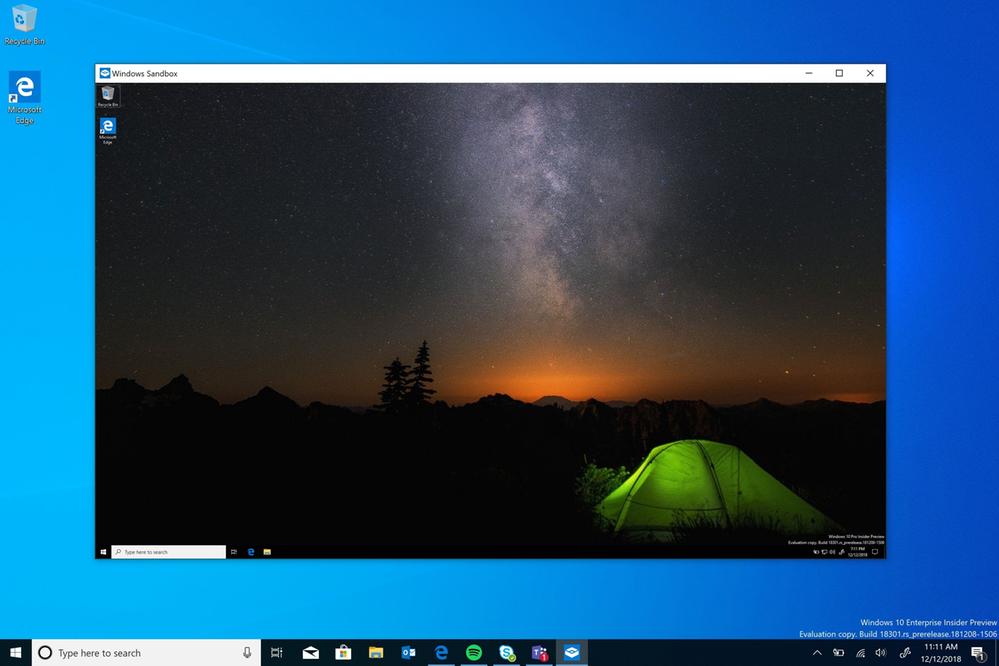Windows Sandbox is an isolated, temporary, desktop environment where you can run untrusted software without the fear of lasting impact to your PC. Windows Sandbox now has support for simple configuration files (.wsb file extension), which provide minimal scripting support. You can use this feature in the latest Windows Insider build 18342.

Any software installed in Windows Sandbox stays only in the sandbox and cannot affect your host. Once Windows Sandbox is closed, all the software with all its files and state are permanently deleted.
Windows Sandbox has the following properties:
- Part of Windows – everything required for this feature ships with Windows 10 Pro and Enterprise. No need to download a VHD!
- Pristine – every time Windows Sandbox runs, it’s as clean as a brand-new installation of Windows
- Disposable – nothing persists on the device; everything is discarded after you close the application
- Secure – uses hardware-based virtualization for kernel isolation, which relies on the Microsoft’s hypervisor to run a separate kernel which isolates Windows Sandbox from the host
- Efficient – uses integrated kernel scheduler, smart memory management, and virtual GPU
There are the following pre-requisites for using the Windows Sandbox feature:
Advertisеment
- Windows 10 Pro or Enterprise build 18305 or later
- AMD64 architecture
- Virtualization capabilities enabled in BIOS
- At least 4GB of RAM (8GB recommended)
- At least 1 GB of free disk space (SSD recommended)
- At least 2 CPU cores (4 cores with hyperthreading recommended)
You can learn how to enable and use Windows Sandbox HERE.
Windows Sandbox Configuration Files
Sandbox configuration files are formatted as XML, and are associated with Windows Sandbox via the .wsb file extension. A configuration file allows the user to control the following aspects of Windows Sandbox:
- vGPU (virtualized GPU)
- Enable or Disable the virtualized GPU. If vGPU is disabled, Sandbox will use WARP (software rasterizer).
- Networking
- Enable or Disable network access to the Sandbox.
- Shared folders
- Share folders from the host with read or write permissions. Note that exposing host directories may allow malicious software to affect your system or steal data.
- Startup script
- Logon action for the sandbox.
By double-click on a *.wsb file you'll open it in Windows Sandboxю
Supported Configuration Options
VGpu
Enables or disables GPU sharing.
<VGpu>value</VGpu>
Supported values:
- Disable – disables vGPU support in the sandbox. If this value is set Windows Sandbox will use software rendering, which can be slower than virtualized GPU.
- Default – this is the default value for vGPU support; currently this means vGPU is enabled.
Note: Enabling virtualized GPU can potentially increase the attack surface of the sandbox.
Networking
Enables or disables networking in the sandbox. Disabling network access can be used to decrease the attack surface exposed by the Sandbox.
<Networking>value</Networking>
Supported values:
- Disable – disables networking in the sandbox.
- Default – this is the default value for networking support. This enables networking by creating a virtual switch on the host, and connects the sandbox to it via a virtual NIC.
Note: Enabling networking can expose untrusted applications to your internal network.
MappedFolders
Wraps a list of MappedFolder objects.
<MappedFolders> list of MappedFolder objects </MappedFolders>
Note: Files and folders mapped in from the host can be compromised by apps in the Sandbox or potentially affect the host.
MappedFolder
Specifies a single folder on the host machine which will be shared on the container desktop. Apps in the Sandbox are run under the user account “WDAGUtilityAccount”. Hence, all folders are mapped under the following path: C:\Users\WDAGUtilityAccount\Desktop.
E.g. “C:\Test” will be mapped as “C:\users\WDAGUtilityAccount\Desktop\Test”.
<MappedFolder>
<HostFolder>path to the host folder</HostFolder>
<ReadOnly>value</ReadOnly>
</MappedFolder>HostFolder: Specifies the folder on the host machine to share to the sandbox. Note that the folder must already exist the host or the container will fail to start if the folder is not found.
ReadOnly: If true, enforces read-only access to the shared folder from within the container. Supported values: true/false.
Note: Files and folders mapped in from the host can be compromised by apps in the Sandbox or potentially affect the host.
LogonCommand
Specifies a single Command which will be invoked automatically after the container logs on.
<LogonCommand> <Command>command to be invoked</Command> </LogonCommand>
Command: A path to an executable or script inside of the container that will be executed after login.
Note: Although very simple commands will work (launching an executable or script), more complicated scenarios involving multiple steps should be placed into a script file. This script file may be mapped into the container via a shared folder, and then executed via the LogonCommand directive.
Configuration Examples
Example 1
The following config file can be used to easily test downloaded files inside of the sandbox. To achieve this, the script disables networking and vGPU, and restricts the shared downloads folder to read-only access in the container. For convenience, the logon command opens the downloads folder inside of the container when it is started.
Downloads.wsb
<Configuration>
<VGpu>Disable</VGpu>
<Networking>Disable</Networking>
<MappedFolders>
<MappedFolder>
<HostFolder>C:\Users\Public\Downloads</HostFolder>
<ReadOnly>true</ReadOnly>
</MappedFolder>
</MappedFolders>
<LogonCommand>
<Command>explorer.exe C:\users\WDAGUtilityAccount\Desktop\Downloads</Command>
</LogonCommand>
</Configuration>Example 2
The following config file installs Visual Studio Code in the container, which requires a slightly more complicated LogonCommand setup.
Two folders are mapped into the container; the first (SandboxScripts) contains VSCodeInstall.cmd, which will install and run VSCode. The second folder (CodingProjects) is assumed to contain project files that the developer wants to modify using VSCode.
With the VSCode installer script already mapped into the container, the LogonCommand can reference it.
VSCodeInstall.cmd
REM Download VSCode curl -L "https://update.code.visualstudio.com/latest/win32-x64-user/stable" --output C:\users\WDAGUtilityAccount\Desktop\vscode.exe REM Install and run VSCode C:\users\WDAGUtilityAccount\Desktop\vscode.exe /verysilent /suppressmsgboxes
VSCode.wsb
<Configuration>
<MappedFolders>
<MappedFolder>
<HostFolder>C:\SandboxScripts</HostFolder>
<ReadOnly>true</ReadOnly>
</MappedFolder>
<MappedFolder>
<HostFolder>C:\CodingProjects</HostFolder>
<ReadOnly>false</ReadOnly>
</MappedFolder>
</MappedFolders>
<LogonCommand>
<Command>C:\users\wdagutilityaccount\desktop\SandboxScripts\VSCodeInstall.cmd</Command>
</LogonCommand>
</Configuration>Source: Microsoft
Support us
Winaero greatly relies on your support. You can help the site keep bringing you interesting and useful content and software by using these options:
